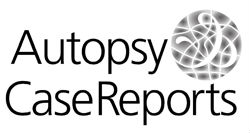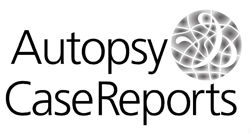Primary abdominal gas gangrene: a report of two autopsy cases
George S. Stoyanov; Deyan L. Dzhenkov; Lilyana Petkova
Abstract
Keywords
References
1 Buboltz JB, Murphy-Lavoie HM.
2 Caplan ES, Kluge RM. Gas gangrene: review of 34 cases. Arch Intern Med. 1976;136(7):788-91.
3 Meyns E, Vermeersch N, Ilsen B, Hoste W, Delooz H, Hubloue I. Spontaneous intrahepatic gas gangrene and fatal septic shock. Acta Chir Belg. 2009;109(3):400-4.
4 Tsokos M, Schalinski S, Paulsen F, Sperhake JP, Püschel K, Sobottka I. Pathology of fatal traumatic and nontraumatic clostridial gas gangrene: a histopathological, immunohistochemical, and ultrastructural study of six autopsy cases. Int J Legal Med. 2008;122(1):35-41.
5 Angelov A. Clinical Pathology of infectious diseases. In: Velev G, Mihaylov I, editors. Textbook of Clinical Pathology. 2nd ed. Sofia: Znanie Ltd.; 1997. p. 299-346. Bulgarian.
6 Yashida M, Ryu M, Watanabe K, et al. An autopsy case of clostridial gas gangrene of the liver. Jpn J Gastroenterol Surg. [Internet]. 1992 [cited 2021 June 4];25:2181-5. Available from:
7 Takeyama M, Mori H, Nagareda T, et al. A case of nontraumatic clostridial gas gangrene occurring in a patient with colon adenocarcinoma, liver cirrhosis, and diabetes mellitus. Acta Pathol Jpn. 1986;36(5):757-64.
8 Sasaki T, Nanjo H, Takahashi M, Sugiyama T, Ono I, Masuda H. Non-traumatic gas gangrene in the abdomen: report of six autopsy cases. J Gastroenterol. 2000;35(5):382-90.
9 Kuroda S, Okada Y, Mita M, et al. Fulminant massive gas gangrene caused by Clostridium perfringens. Intern Med. 2005;44(5):499-502.
10 Miyata Y, Kashiwagi H, Koizumi K, et al. Fatal liver gas gangrene after biliary surgery. Int J Surg Case Rep. 2017;39:5-8.
11 Clark MA, Worrell MB, Pless JE. Postmortem changes in soft tissues. In: Haglund W, Sorg M, editors. Forensic taphonomy: the postmortem fate of human remains. Boca Raton: CRC Press; 1997. p. 156-64.
12 Carman RJ, Sayeed S, Li J, et al. Clostridium perfringens toxin genotypes in the feces of healthy North Americans. Anaerobe. 2008;14(2):102-8.
13 Ngo JT, Parkins MD, Gregson DB, et al. Population-based assessment of the incidence, risk factors, and outcomes of anaerobic bloodstream infections. Infection. 2013;41(1):41-8.
14 Watanabe N, Kobayashi K, Hashikita G, et al. Hepatic gas gangrene caused by Clostridium novyi. Anaerobe. 2019;57:90-2.
15 Doblecki-Lewis S, Palaios E, Bejarano PA, Tzakis AG, Selvaggi G, Morris MI. Hepatic gas gangrene following orthotopic liver transplantation: three cases treated with re-transplantation and a review of the literature. Transpl Infect Dis. 2008;10(4):280-5.
16 Hadem J, Westerkamp V, Trautwein C, Winkler M, Manns MP, Hafer C. Hepatic gas gangrene following liver transplantation. Liver Transpl. 2007;13(3):468-9.
17 Kitterer D, Braun N, Jehs MC, Schulte B, Alscher MD, Latus J. Gas gangrene caused by clostridium perfringens involving the liver, spleen, and heart in a man 20 years after an orthotopic liver transplant: a case report. Exp Clin Transplant. 2014;12(2):165-8.
Submitted date:
06/04/2021
Accepted date:
08/14/2021
Publication date:
09/23/2021


